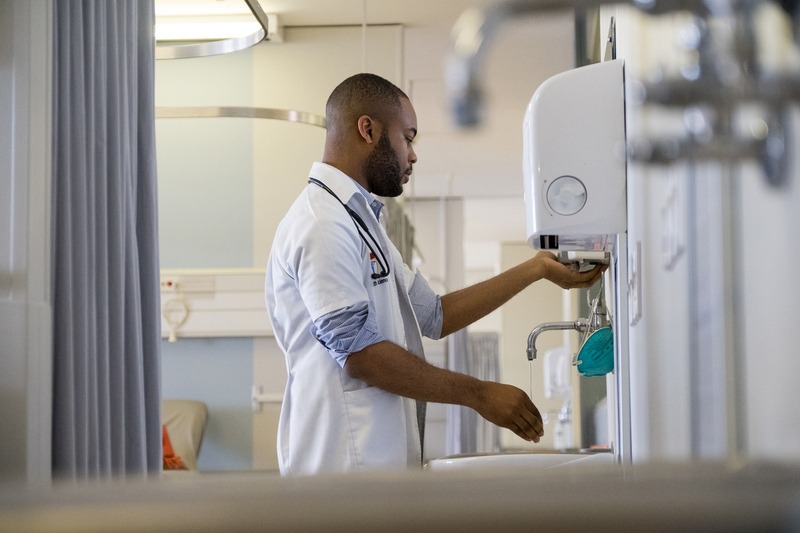What Is Antimicrobial Fabric?
Antimicrobial fabric is a boon in the medical field for a number of reasons, from sanitation and safety to material longevity and ease of use.
Typically included during the spinning process, antimicrobial agents are adhered to the fibers in clothing, gauze, sheets, and other fabrics, specifically inhibiting the growth of microorganisms or even going so far as to destroy them.
While it’s basic knowledge that the first step in staying healthy and avoiding microbial attacks is sanitation, antimicrobial fabrics provide a necessary layer of defense against common contaminants in spills, stains, and much more.
What is Antimicrobial Fabric?
Medical professionals spend countless hours every month working in direct contact with ill patients, biological samples, and potential sources of disease. While a strong immune system goes a long way, the body needs more protection – especially when working long hours, under extreme amounts of stress.
Beyond just keeping us safe, however, antimicrobial fabrics present an interesting view into two topics of increasing importance over the years:
- The prevalence and threat of powerful microbes and superbugs.
- The role that antimicrobial products will continue to play in the future, especially in hospitals and other places that represent a perfect breeding ground for these threats.
Why are Microbes Bad?
Before anything else, it’s critical to stress that there is no such thing as a bad or good microbe. Microbes, or microorganisms, are critical for all life functions and exist in us and around us.
Our gut health, which is vitally important for a wide variety of functions from proper bowel control and detoxification to mental health, relies on a strong and robust biosphere consisting entirely of microbes. Within the human body itself, the sheer number of ‘foreign’ microorganisms outnumbers our very own cells. This is normal, and necessary.
Other animals are much the same. As a whole, our ecology relies on the constant cooperation and interaction between the micro and the macro. Germs, despite the negative connotations they might have, are as critical to life as oxygen and water.
However, for a person to be healthy, they need a certain balance. If there is a significant disturbance in that balance, bad things can happen. While our own health relies on microbes, there are many external microorganisms that can wreak havoc on the delicate balance we maintain within ourselves.
The Need for Sterilization
That’s where sterile equipment becomes important, especially when interacting with sick patients. Viruses, specific bacteria, and a variety of germs can negatively impact our health, from catching the common cold to getting a stomach bug, and much more dangerous infectious diseases.
The majority of microbes around us are harmless. Those that are potentially dangerous are often neutralized by a healthy and strong immune system. But some are extremely dangerous, and in environments like hospitals, where professionals are under constant stress and in constant exposure to a variety of potential contaminants, protection against microorganisms is critical.
Fabrics play a very vital role here as they are in contact with our skin. In addition the interlacing nature of fabrics makes them ideal for trapping moisture and providing the perfect breeding grounds for countless different microbes.
Antimicrobial fabric helps to combat this problem, not only by directly hindering or even stopping the exponential growth of microbes, but also by incorporating other critical technology to avoid bacteria growth like moisture-wicking.

The Importance of Quality Fabrics in Medicine
In any medical practice or hospital, what the staff wear is critically important. Fabrics help with identifying a member of staff from other patients or visitors, and also provide a myriad of ergonomic benefits in high-quality medical uniforms. Scrubs, lab coats, and other uniforms need to be designed with the strenuous needs of the job kept in mind. The standards for a high-quality set of scrubs include:
- Odor-repellent
- Moisture-wicking
- Antimicrobial
- Breathable
- Tailored for performance
High quality scrubs can go a long way for a busy and stressed medical professional, especially in a contaminated environment. Antimicrobial scrubs can not only help nurses and doctors avoid contamination, but it could help them stay healthy and capable over long shifts.
History of Antimicrobial Fabric
Antimicrobial fabrics are nothing new. Before modern history, ancient civilizations relied on a number of techniques to ensure that they were working with slightly more sanitary cloth, as Egyptians relied on specific resins and chemical agents available to them at the time when embalming their dead. This is partly why Egyptian mummies are extremely well-preserved (alongside other factors).
In Japan, artisans relied on fermented fruit juice (harvested from unripe persimmons) to dye some of their products, and apparently lend them some antibacterial properties through tannin – similar to tannins and other phytochemicals found in various different kinds of wood.
In more modern history, silver-treated fabrics and cloths drenched in antimicrobial chemicals aided soldiers during World War II, preventing fabrics from rotting away after coming into contact with moisture. Copper, chlorine salts, and other agents would stiffen the fabric and make it antibacterial, sometimes at the cost of the environment or an officer’s health.
Since then, rigorous testing and plenty of regulations have led to the discovery of a myriad of safer alternatives for creating antimicrobial fabrics without endangering lives. However, some issues persist.
Modern Considerations of Antimicrobial Fabric
Antimicrobial fabrics today must adhere to strict regulations set by the FDA. All products that advertise themselves as antimicrobial go through rigorous testing. Because antibiotic-resistant bacteria have become a growing issue, antimicrobial fabric is a critically important subject.
- Their sale and production must be carefully monitored to avoid environmental damage, health issues, or other potential problems. As such, products that are legitimately antimicrobial have undergone a series of tests and are suitable for wear and everyday use.
- Their antimicrobial properties can also help them stay intact and free from potential rot or decay, further increasing their longevity.
This environmentally conscious aspect of antimicrobial fabric is critical, as the drastic rate at which we throw out our fabrics contributes heavily to the amount of microplastic in the environment, which in turn is ending up in our own drinking water, and our bodies.
Lastly, it’s important to note that there is no such thing as a totally sterile environment. Although equipment can be kept sterile, proper sanitization and frequent hand washing can help reduce the rate of infection in a hospital setting, it’s never 100%. Utilizing antimicrobial fabrics can further combat contamination.
Final Thoughts
Eliminating contaminants and fighting to keep down infection rates is important to patient longevity and preventing healthcare-associated infections (HAIs).
In addition, it effectively helps with combating the growing problem of antibiotic-resistant bacteria and so-called super bugs. Antimicrobial fabric can and will continue to play an important role in this.



